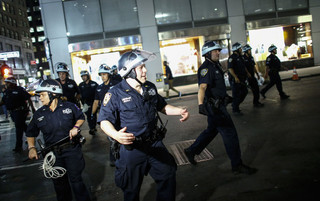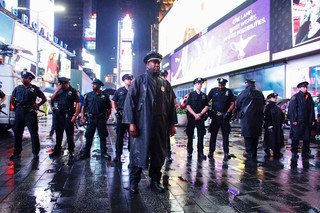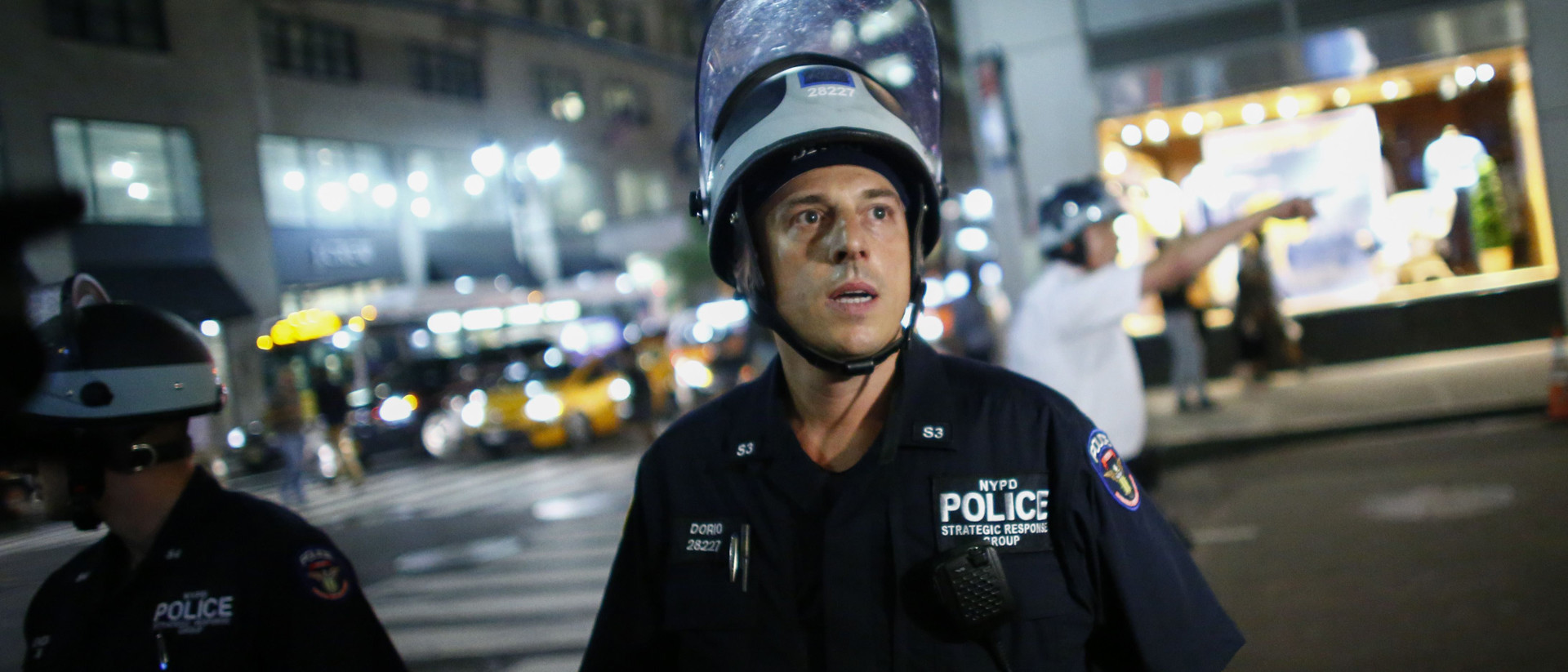In 2014, I got a notification from my son’s preschool that they were practicing “riot drills” with the three-year-olds.
It was November 2014, and my city, St. Louis, was under a “state of emergency.” The reason? The impending decision in the case of Darren Wilson, the officer in Ferguson who shot Michael Brown, a black teenager, to death in August, was spurring mass protests against police brutality. The protests against police brutality were met with more police brutality, as officers fired tear gas and rubber bullets at grieving crowds. As St. Louis spent an anxious autumn awaiting the decision, tanks began to appear at everyday places like malls, and soldiers patrolled boarded up shops. Mundane life became militarized. St. Louis residents, black and white, braced themselves for what was to come when justice was inevitably denied.
What everyone was afraid of
Would the city burn? Would St. Louis’s age-old practices of racist and brutal policing finally cease, now that our police corruption was an international talking point? How do you raise children in a city like this, in a country like this?
But none of that came to pass. What happened to St. Louis was worse: a reversal to the status quo of systemic, racist police brutality
My son’s “riot drills” were a desperate grasp at order at a time when everything felt unpredictable and volatile. No one in St. Louis knew who to trust when authorities were the cause of violence that authorities were supposed to prevent. The impending jury decision – which most felt, due to precedent, would be in favor of the police – shook the public imagination. Frightened citizens predicted lawlessness and destruction on an unforeseen scale. Activists envisioned reform and repercussions – that the chaos of Ferguson might finally force lawmakers to make police face consequences for acts of violence against black citizens.
But none of that came to pass. What happened to St. Louis was worse: a reversal to the status quo, with full knowledge that the status quo meant systemic, racist police brutality.
For one night, a few blocks of Ferguson burned. Then the streets were cleaned up, the storefronts reopened, the state of emergency was lifted, commissions were formed to investigate – and the killing of black men continued.

Police officers during a Black Lives Matter demonstration in New York City on July 8, 2016. Photo by Kena Betancur / AFP
What really happened
Since August 2014, when Michael Brown was killed, thirteen men have been killed by St. Louis city or county officers. Only one of them was white. The officers who killed them seldom faced any consequences. Sometimes they received praise, or even money, as in the case of Wilson, who raised nearly one million dollars in sympathetic donations.
Throughout the country, the pattern was replicated: the killings of Tamir Rice of Ohio, Freddie Gray of Maryland, Walter Scott of South Carolina and others spurred protests but little repercussion. In the majority of cases, officers were not indicted. If they were indicted, they were usually judged not guilty. U.S. media emphasized the character flaws or perceived mistakes of the victims – even Rice, who was only twelve years old. Police killings of black men and boys were deemed either justified or a “mistake”, a term which masks the depth of trauma: that a human being’s life was taken, his loved ones left to grieve.
Technology changes, but state-sanctioned brutality against black men does not
Shortly after the Fourth of July, Alton Sterling of Louisiana and Philando Castile of Minnesota were killed by police. Both killings were captured on video, with Castile’s death narrated by his girlfriend on Facebook Live. The videos were frightening not only due to their graphic nature, but their likely futility as a means to justice. Some 25 years ago, the brutal beating of Rodney King in Los Angeles was captured on video by a bystander. The documentation of police brutality, new at the time, made many hopeful that officers would be punished. Instead, the officers were judged not guilty, and Los Angeles burned as angry citizens took to the streets in the 1992 riots.
America lives out this nightmare over and over again. Technology changes, but state-sanctioned brutality against black men does not.

Police officers during a Black Lives Matter demonstration in New York City on July 8, 2016. Photo by Kena Betancur / AFP
What Frederick Douglass saw on another Fourth of July
The problem of police brutality against black citizens is not new. It predates America itself, born out of the same mindset that rationalized black slavery in the colonies. American history is a selective narrative, one that purposefully eliminates or delegitimizes the brutality blacks face from state and local officials. On July 5, 1852, Frederick Douglass, a social reformer born into slavery, reflected on what the Fourth of July meant for black Americans:
America is still false to its past, false to its present, and well on its way to being false to the future
“I shall see, this day, and its popular characteristics, from the slave’s point of view,” he proclaimed. “Standing, there, identified with the American bondman, making his wrongs mine, I do not hesitate to declare, with all my soul, that the character and conduct of this nation never looked blacker to me than on this 4th of July! Whether we turn to the declarations of the past, or to the professions of the present, the conduct of the nation seems equally hideous and revolting. America is false to the past, false to the present, and solemnly binds herself to be false to the future.”
Alton Sterling was killed on the 164th anniversary of Douglass’s speech – in an America still false to its past, false to its present, and well on its way to being false to the future.

Police officer during a Black Lives Matter demonstration in New York City on July 8, 2016. Photo by Kena Betancur / AFP
“The Talk”
In the aftermath of the police shootings of black citizens, prominent Americans call for a “conversation on race”, but that call is often made with euphemisms. Politicians speak of the killings as “officer-related incidents”, a term so vague it could refer to any encounter with the law. Police departments issue statements saying “shots were fired”, as if shots materialized in thin air, and were not fired by an officer into the body of a black man who died. To state the truth plainly – “American police officers can shoot black men to death for no reason and face no punishment” – is to provoke empathy for the victims, and to recognize the officer who did the fatal shooting for what he is: a state-sanctioned executioner.
No American wants to feel that those who are supposed to serve and protect us are legally sanctioned to kill us. The difference is that for non-black Americans, noting the possible brutality of law enforcement is a matter of choice, whereas for black Americans, it is a matter of survival. Non-black Americans have the option of avoiding the topic, while black Americans must have “the talk” with their children: lessons passed down through generations on how to survive encounters with police. The disjuncture between black and non-black America that Douglass noted in his speech continues to this day. It persists because of the refusal of non-black Americans to see targeted brutality toward black Americans as a shared problem, one which they are complicit in through their refusal to listen or to believe firsthand accounts of abuse.
For non-black Americans, noting the possible brutality of law enforcement is a matter of choice, whereas for black Americans, it is a matter of survival
In the week that my three-year-old son was practicing Ferguson riot drills at preschool, my daughter, then a first-grader, was playing at the bus stop with her classmates, all of whom are black. (We live in a majority black St. Louis neighborhood.) As they waited for the bus, the kids ran around, chasing each other with sticks and laughing, until a kindergartener, giggling, proclaimed, “Don’t come after me – or I’ll call the police!”
“Don’t call the police!” the rest of the kids shouted in unison, the game suddenly forgotten. A 10-year-old explained to me that once her family had called the police for help, and an officer had ended up abusing and arresting her uncle for no reason. The older kids nodded. Never call the police, they warned. The police could not be trusted. My daughter, the lone white kid, looked at me blankly.
My neighborhood is not dangerous or crime-ridden. It is an ordinary place, but black children here had seen or heard about enough police misconduct that jokes about police inspired real fear. My daughter knew no such history, and that night I had the white parent version of “the talk”: I explained what had happened to Michael Brown five miles away in Ferguson, and that she and her brother, as white Americans, were not at risk. Crying, she asked if what happened to Brown could happen someday to her friends at school, and I had to tell her that yes, it could.

Police officers during a Black Lives Matter demonstration in New York City on July 8, 2016. Photo by Kena Betancur / AFP
The shared problem that non-Black Americans refuse to see
Much of the focus on the Sterling and Castile cases has been on the videos – raw documentation that proves what black Americans have been claiming all along. Given the track record of cases like Rodney King’s, Americans have learned that documentation of police brutality does not guarantee justice. It is a travesty that video is not enough to prove the misconduct of law, but the true tragedy is that video is deemed necessary at all. For centuries, black Americans have spoken out about abuse of law enforcement – as victims, and as witnesses. The problem is not lack of evidence. It is the refusal of the non-black public to believe it.
In the back of Philando Castile’s car, a four-year-old black girl watched her mother narrate his death. She became a child witness to state-sanctioned murder. If there hadn’t been video, would people believe her story? Would they believe her mother? Would they believe the stories of other black children whose families have faced racial profiling, abuse, and even murder at the hands of the police? Or will our children continue to inherit what Douglass proclaimed – an America false to its future, refusing to confront its cruelty and flaws?
More from De Correspondent:
 On the ground in Flyover Country
Much of our news comes from the East or the West Coast. But what about that vast space in between, the ‘Flyover Country’? Home to more than half the nation’s people, it is here in the American heartland that presidents are made. Join me in the run-up to the November election, as I report on the U.S. from Middle America.
On the ground in Flyover Country
Much of our news comes from the East or the West Coast. But what about that vast space in between, the ‘Flyover Country’? Home to more than half the nation’s people, it is here in the American heartland that presidents are made. Join me in the run-up to the November election, as I report on the U.S. from Middle America.
 Why talking is lying
Muslims, bankers, liberals – we use some terms so automatically, we don’t realize they are actually little lies of language. And little lies have a way of turning into big lies.
Why talking is lying
Muslims, bankers, liberals – we use some terms so automatically, we don’t realize they are actually little lies of language. And little lies have a way of turning into big lies.
 Everything you need to know about Brexit
The people of the UK have voted to leave the European Union and the prime minister has resigned. What’s going on with Britain? And what will a Brexit mean for Europe and the rest of the world? From the UK, I answer your most pressing questions.
Everything you need to know about Brexit
The people of the UK have voted to leave the European Union and the prime minister has resigned. What’s going on with Britain? And what will a Brexit mean for Europe and the rest of the world? From the UK, I answer your most pressing questions.
 This is the Berlin Wall of our time
Syrian refugees continue to flee the country in droves, but a solution to the conflict there remains elusive. Why? The answer may seem surprising, but our greatest obstacle on the road to peace in the world could well be veto rights in the United Nations.
This is the Berlin Wall of our time
Syrian refugees continue to flee the country in droves, but a solution to the conflict there remains elusive. Why? The answer may seem surprising, but our greatest obstacle on the road to peace in the world could well be veto rights in the United Nations.



